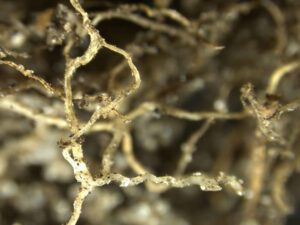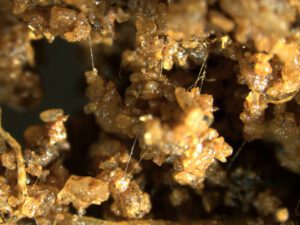One of the true rock stars in the soil ecology world is our good friend Dr. Christine Jones. She is an internationally renowned and highly respected groundcover and soils ecologist and has taught here at our farm several times in recent years. She has a wealth of experience working with innovative landholders to implement regenerative land management practices that enhance biodiversity, increase biological activity, sequester carbon, activate soil nutrient cycles, restore water balance, improve productivity and create new topsoil.
In human society, a quorum is the number of members of an organization that must be present in order for decisions to be made and business to be transacted. In the microbial world, the term quorum sensing (QS) refers to density dependent coordinated behavior that regulates gene expression in the microbial population and/or in the host plant or animal.
Quorum sensing was first described in the 1960s in relation to the expression of bioluminescence in the marine bacterium Vibrio fischeri. When free-living in the ocean, V. fischeri is non-luminescent, but when populations reach a critical population density they ‘shine’… but only in the dark. The bacteria know ‘how many’ of them there are – and they also know that it’s dark.
Microbes can’t see, think, or hear. But by means of chemical signals, calledauto-inducers, they have the capacity to detect how many others are in their vicinity – both of their own species and of other species. In the last decade, research into quorum sensing has grown exponentially. It is now recognized that quorum sensing is utilized by bacteria, archaea, fungi and viruses in all habitats – in water, on land, in plants, on plants, in the soil and in animals and humans.
Social insects like ants and bees also use signals to communicate. A single bee behaves very differently to a colony of bees. Similarly, a single bacterium behaves very differently to a colony of bacteria. And even a colony of one kind of bacteria behaves very differently when it is the only colony – compared to when there are multiple colonies of many kinds of bacteria.

Crops seeded into chemically-fallowed soil in the presence of high rates of N have bare roots. In the absence of a microbial quorum there is no protection from pests and diseases and no soil building.

The roots of crops direct drilled into diverse cover without the use of high-analysis fertilizers support a protective, soil-building microbial quorum.
Quorum sensing in the soil microbiome enables multi-species crops and pastures to function more effectively than monocultures. Once the diversity of plants and hence the diversity of functional groups of soil microbes reaches a certain threshold – or quorum – everything changes. The microbial community begins to function as a coordinated ‘super-organism’ and can perform tasks that individual microbes cannot achieve alone. The lights come on, not unlike the bioluminescent marine bacteria that suddenly shine brightly in a dark ocean.
Quorum sensing also helps explain how biostimulants improve plant health, even at very low concentrations. The biochemical signals mimic plant and microbial diversity, resulting in the production of growth stimulating and plant protection hormones.
Disease-causing organisms use quorum sensing to express virulence and pathogenicity. The good news is that once the configuration of the signals has been determined, they can be scrambled and rendered ineffective by a process termed ‘quorum quenching’ (QQ). Quorum quenching is proving to be more effective than antibiotics and fungicides, which kill everything, good or bad.
In soils, both QS and QQ are important for the function and resilience of plant communities, not only in the face of biotic stresses (e.g. pests and diseases) but also in regards to promoting health, abundance and resilience in the face of abiotic stress (such as drought, frost, and nutrient deficiencies).
There is much to be gained by applying our understanding of quorum sensing in the agricultural space. QS is the only process that adequately explains the extraordinary results (such as abundant nutrient availability and enhanced drought tolerance) observed once plant diversity – and hence microbial diversity – reach a critical threshold, or tipping point.
The flip side to quorum sensing is that when there are not enough microbes to form a quorum, nothing happens. No matter whether it is in the human or animal gut – or in the soil – when microbial populations do not attain a quorum some very important genes (that plants, animals, and people require for immunity, for example) get switched off. The lights go out… which is precisely what’s happening today in human, animal, plant and soil health.
We need to figure out how to turn the lights back on…
and fast.
THIS ARTICLE CAN BE FOUND ON PAGES 52 OF THE SOIL HEALTH RESOURCE GUIDE: VERSION 9.
